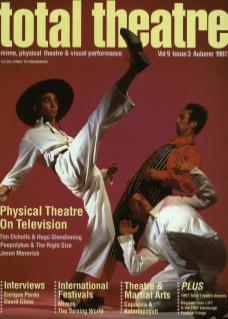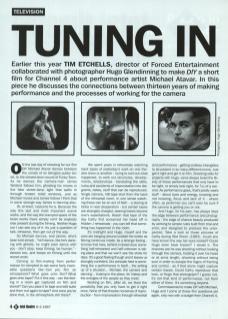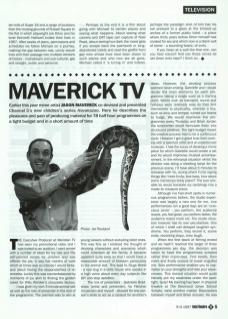On the last day of shooting for our film DIY Michael Atavar dances between the urinals of an Islington public toilet, to the slowed down sound of Funky Town. As he dances the camera-man James Welland follows him, ghosting his moves in the fake street-lamp light that spills in through broken toilet windows, and as Michael moves and James follows I think that in some strange way James is dancing also.
Or, at least, I assume he is. Because the way this last and most important scene works, and the way the cramped space of the toilet works, there simply can't be anybody else present during the filming. Neither Hugo nor I can see any of it. It’s just a question of talk, rehearse, then get out of the way.
So Michael dances, and James, who's been told simply – ‘he'll dance, like he's dancing with ghosts, he might even dance with you – don't stop, keep filming, be human’ – dances too, and keeps on filming until the record ends.
Coming to film-making from performance I'm tempted to ask some fairly insensible questions like: Can you film an atmosphere? What goes onto film? What goes onto tape? Put it this way – can the feeling in a room get captured on film and stored? Can you pass it to tape and edit suite and then out again to tape? And once you've done that, is the atmosphere still there?
We spent years in rehearsals watching back tapes of yesterday's work on one theatre show or another – trying to sort out what happened, to work out structures, developments, relationships – translating the skills, lucks and accidents of improvisation into diagrams, notes, stuff that can be reproduced. Single camera, hi8 tape shot from the back of the rehearsal room. In one sense watching these can be an act of faith – a staring at blobs in near desperation – but certain tapes are strangely charged, bearing traces beyond one's expectations. Watch that tape of the day Cathy first screamed her head off in Hidden rehearsals – you can tell that something has happened in the room.
It's midnight and Hugo, myself and the crew are hanging around outside the toilets as filming continues inside. It’s a strange feeling – to know that here, behind a closed door, something half-rehearsed and half-unknown is taking place and that we won't see the shots for days. It's a good feeling though and it leaves us strangely confident. Our principle here is something like a performance in itself... the setting up of a situation... Michael, the camera and dancing... trusting to the place, its history and the energies of the people as they meet.
Working on film, after all, we liked the possibility that you only have to get it right once. None of that theatre nonsense of reproduction – from improvisation through rehearsal and performance – getting endless intangibles to be present in so many different rooms. Just get it right and get it on film. Shooting stills for projects with Hugo, we've always loved the liberty of those performances that only have to be right, or simply look right, for .425 of a second. As performance goes, that's pretty weird stuff – about eyes and energy, knowing and not knowing, focus and lack of it – where often, as performer, you can't even be sure if the camera is getting you or not.
And Hugo, for his part, has always liked the edge between performance and photography – the edge of chance beauty produced by working to simple rules built from trial and error, and designed to produce the unexpected. Take a look at those pictures of Cathy during Red Room (1993). Could she have known the way her eyes looked? Could Hugo even have known? I doubt it. The chances are he was shooting without looking through the camera, holding it over his head or at arm’s length, shooting without being sure in order to escape the logics of framing and control – as if that alone might capture certain traces. Could Cathy reproduce that look, or Hugo that photograph? I guess not, it's not that kind of performance, not from either of them. It's something beyond.
Commissioned to make DIY with Michael, Hugo and I come at these film questions yet again, only now with a budget from Channel 4, ten rolls of Super 16 and a range of locations from the cruising grounds of Russell Square to the flat in which playwright Joe Orton and his lover Kenneth Halliwell ended their lives in 1967. After weeks of plans, permissions and schedules we follow Michael on a journey, marking the gap between real, unruly sexual lives and their passage into multiple versions of history – mainstream and sub-cultural, gay and straight, public and personal.
Perhaps at the end it is a film about going with Michael to certain places and seeing what happens. About seeing what camera and DAT tape can capture of Noel Road, about seeing how dark the mood gets if you scrape back the paintwork in long-abandoned toilets and read the graffiti from gay men whose lives have been drawn to such places and who now are all gone. Michael called it 'a tuning in' and indeed, perhaps the paradigm shot of him has his ear pressed to a glass at the bricked-up arches of a former public toilet – a place where thirty years before Orton himself had cruised for sex and which now is a blank wall of stone – a sounding board, of sorts.
If you listen at a wall like that one, can you hear voices? And can those voices be set down onto tape? I think so.


